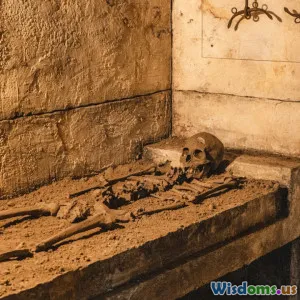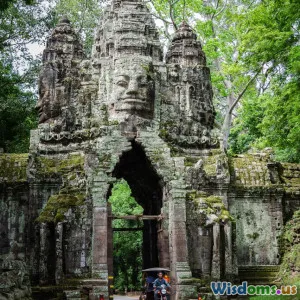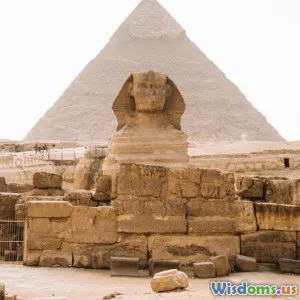
Why Mainstream Historians Avoid The Younger Dryas Impact Theory
16 min read Explores reasons why mainstream historians remain skeptical of the Younger Dryas impact theory, analyzing evidence, academic debates, and scientific controversy. (0 Reviews)
Why Mainstream Historians Avoid The Younger Dryas Impact Theory
The story of humanity's past is in constant flux. Nowhere is this more evident than in the simmering debate surrounding the Younger Dryas Impact Hypothesis—a bold theory that an explosive comet collision dramatically altered Earth's climate just over 12,800 years ago. The resulting cold snap, argued impact proponents, devastated megafauna, and profoundly affected early human societies. Yet, despite a cascade of intriguing evidence, most mainstream historians continue to keep this theory at arm's length. Why does this idea, so compellingly cinematic, remain on the academic fringe? The answer lies at the crossroads of science, skepticism, and the very nature of historical inquiry.
The Origins of the Younger Dryas Hypothesis

The Younger Dryas period is so named for an alpine flower—Dryas octopetala—that flourished with the abrupt return of glacial conditions in the North Atlantic region approximately 12,800 years ago. As scientists probed ice core samples from Greenland in the latter 20th century, they discovered startlingly sharp temperature fluctuations marking the beginning and end of the Younger Dryas. One moment, the world was warming as the last Ice Age receded; the next, deep freeze—a swing of up to 10°C in decades, not millennia, before warming resumed just as fast.
How could such a climate shock occur? The leading explanations, backed by geology and oceanography, pointed to shifts in massive freshwater flows—when glacial Lake Agassiz burst, pouring into the North Atlantic and disrupting thermohaline circulation. Mainstream historians, seldom geologists themselves, accepted this robustly supported but unimaginative answer.
The comet impact theory shattered this consensus. In 2007, a team led by physicist Richard Firestone, Allen West, and geologist James Kennett published evidence for a cosmic cataclysm: widespread layers of carbon spherules, nano-diamonds, and rare metals like iridium, typically associated with extraterrestrial impacts, on four continents at the Younger Dryas boundary. The "Younger Dryas Impact Hypothesis" was born—a dramatic suggestion that a fragmented comet exploded over North America, vaporizing an ice sheet, sparking continent-wide fires, and plunging the planet into a mini Ice Age.
Scientific Scrutiny and Standards of Evidence

For the skeptically minded historian, compelling stories demand scrupulous support. Unlike the relatively well-studied Cretaceous–Paleogene (K-Pg) impact event, which wiped out the non-avian dinosaurs, the Younger Dryas Impact Hypothesis faces several hurdles:
Replicability and Reproducibility: Science depends on independent replication. Many teams have attempted (with mixed results) to reproduce Firestone's findings. For example, the presence of nanodiamonds at the boundary layer was confirmed in some sediment layers in North America and Europe but failed to appear elsewhere, or were found in older and younger strata as well. Doubts arose if the markers were sufficiently unique to point toward an impact event.
Dating and Correlation: Linking proxy evidence—like magnetic grains and soot—or the controversial "black mat" layer worldwide to the exact Younger Dryas onset is a daunting chronological challenge. Mainstream historians, trained to caution against 'coincidental' dating without strict synchronization, cite these ambiguities. As noted by Bradley et al. (2010), the margin for radiocarbon error is often a few hundred years—blurring any precise cause-and-effect relationship.
Alternate Explanations: Many of the same markers indicating destruction (wildfires, platinum spikes, climate fluctuation) can occur due to terrestrial phenomena: volcanic activity, natural fire regimes, or gradual climatic shifts unrelated to cosmic impacts. The absence of unique 'smoking gun' evidence, akin to the Chicxulub crater for the K-Pg event, weighs heavily on scholarly minds.
When theories are built from ambiguous proxies and require a complicated chain of interpretation, wariness is the professional historian's ally.
Historians' Interdisciplinary Terrain

While much of the debate rages in geology and paleoclimatology, the implications extend into the historian's domain—especially the emergence of complex societies after the Ice Age. Historians, by training, operate within a web of disciplines: archaeology, paleobotany, genetics, and climatology. Their adherence to methodical, interdisciplinary synthesis often makes radical hypotheses unattractive.
For example:
- Settling New Worlds: Archaeological sites like Göbekli Tepe in Turkey (beginning ca. 9600 BC) and Clovis culture in North America are often discussed in light of both climatic and cultural shifts. While catastrophism offers a grand explanatory narrative—cataclysm leading to cleared landscapes and dramatic change—mainstream historians find gradualist approaches, such as shifting foraging strategies or regional adaptation, better aligned with the sedimentary and artifact record.
- Peer Dependence: Academic historians rely on consensus frameworks; integrating controversial new models requires changes in how university courses, textbooks, and broader interpretations are developed. For historians, a surprising claim isn’t just a scientific issue, but an educational, communicational, and professional challenge too.
As one critic, archaeologist David Meltzer, observed, "If there is an extraterrestrial smoking gun, it remains frustratingly out of sight." Teachers turn such criticisms into caution—waiting for broader confirmation before revolutionizing their lectures.
Evaluating the Impact Theory's Evidence: Analysis and Comparison

Debate over the Younger Dryas Impact Hypothesis hinges on key lines of inquiry:
1. Geological and Geochemical Markers
Advocates for the impact theory point to nanodiamonds, microspherules, magnetic grains, and platinum anomalies as hallmark signatures of cosmic impact. For instance, James Kennett and colleagues have documented peaks of platinum in Greenland ice cores exactly at the Younger Dryas boundary (PNAS, 2018)—a tantalizing match to what would be expected after a massive extraterrestrial event. Similarly, supposed "black mats" rich in carbon and soot appear across North America, interpreted as burned biomass from impact-caused wildfires.
Skeptics, however, highlight that:
- Not all independent labs confirm these compositions in their samples.
- Some geochemical signatures (such as magnetic spherules) can arise from terrestrial processes, including wildfires and volcanic eruptions.
- No definitive impact crater contemporaneous with the event has been identified, despite surveys in North America and Greenland (where sedimentary lakes like Hiawatha have been proposed but lack conclusive dating).
2. Archaeological and Biological Correlates
Proponents argue for temporal coincidence between this hypothesized impact, abrupt fauna extinctions (such as the mammoth and saber-toothed cat), and the stylistic shift from Clovis to post-Clovis stone tool traditions. Critics claim that archaeological records demonstrate a protracted, regionally varied extinction and cultural adaptation—suggesting ecological stress rather than instantaneous destruction. For example, evidence for megafaunal survival in isolated refugia post-dates the supposed impact.
3. Ice Core Chronicles vs Terrestrial Layering
Perhaps the most powerful contradiction lies in clean, continuous records from Greenland's ice cores. These show a sudden temperature drop at the Younger Dryas onset but lack the superimposed debris layers, soot, and chaos found in K-Pg layers worldwide. Had a sufficiently massive explosion vaporized an ice sheet, such evidence might be expected. Its absence is a gulf mainstream scholars cannot cross.
Paradigms and the Nature of Resistance

Why do new scientific models often meet with fierce resistance? The historian Thomas Kuhn, in his landmark 1962 work The Structure of Scientific Revolutions, argued that scientific communities naturally defend prevailing "paradigms." These paradigms, built from mountains of consistent data and cross-disciplinary reinforcement, cannot be overthrown by anomalies alone—but require overwhelming evidence. Those advocating paradigm-smashing ideas must therefore clear an unusually high bar; until then, mainstream practitioners exhibit a collective "trained incapacity" to radically revise their models.
Historians, whose stock-in-trade is evaluating cause and effect over long periods, gravitate toward theories explaining change as evolving complexity, not overnight catastrophe. Catastrophism, for all its appeal, is often reserved for moments where evidence is both unambiguous and overwhelming (as with dinosaur extinction, confirmed only by the global Chicxulub layer and crater in the 1980s—over a century after the event itself was hypothesized by Luis and Walter Alvarez).
Moreover, academic history is tied closely to process rather than event. 'Process-based' models explain transformations (like the rise of agriculture or social complexity) through cumulative pressures, not abrupt shocks, shaping mainstream receptivity to impact-based models.
The Stakes: Broad Reverberations of Acceptance

Should the Younger Dryas Impact Hypothesis gain acceptance, its implications reach beyond geoscience to how we frame the origins of civilization:
- Human Migration and Demographic Collapse: The cataclysmic view holds that cometary bombardment would have depopulated entire landscapes, altering the tempo of Paleoindian migration and necessitating fundamental shifts in subsistence. Acceptance would encourage a sweeping revision of population models and social resilience narratives.
- Narrative Resonance and the "Flood Myths": Widespread ancient legends, from Mesopotamian Gilgamesh to biblical Noah, speak of great floods and destruction. While alluring, professional historians are trained to guard against 'concordance' bias—the risk of reading literal truth in symbolic myths.
- Scientific Communication and Public Trust: Mainstream historians are, by necessity, gatekeepers of academic consensus, and aware of their public role. Sudden acceptance (or rejection) of radical ideas can upset broader trust in scholarly expertise unless timed carefully and evidence-based.
The consequences for textbooks, museums, classroom narratives, and even theories of human psychology would be profound. Against such stakes, historians’ caution is both understandable and expected.
Lessons from Other Scientific Debates

Much can be learned from the annals of other scientific controversies:
- Dinosaurs and Asteroids: While extinction by asteroid is now mainstream, it too faced skepticism for decades. Only a preponderance of physical evidence—and an unmistakable crater—won over the scientific community.
- Continental Drift/Plate Tectonics: Alfred Wegener, who posited that continents drifted apart, was dismissed by geologists and historians alike during his lifetime. Only after evidence from ocean floor mapping and seismic monitoring in the 1960s did his ideas take root.
- Clovis-First Model Challenged: For much of the 20th century, the "Clovis First" paradigm held that the earliest humans arrived in the Americas around 13,000 years ago. Today, mounting evidence from sites like Monte Verde in Chile demonstrates that human presence predates Clovis by at least a millennium, though the debate was grueling and protracted.
These examples illustrate two themes: science, including historical science, is inherently conservative—and game-changing theories are ultimately put to the test by the sheer accumulation of data, not by persuasion or punchy hypotheses alone.
The Responsible Embrace of Uncertainty

If the story of the Younger Dryas tells us anything, it is that historical truth advances cautiously. Disciplined inquiry, skepticism, and transparency guard against both premature consensus and unwarranted dismissal. Mainstream historians resist the Younger Dryas Impact Hypothesis not out of stubbornness or lack of imagination, but from a measured commitment to the rigor that holds their discipline together.
There is, of course, a virtue in continued curiosity. A new sediment layer revealed by deep drilling, or robust dating of an elusive sub-ice crater, could yet tip the scales. Ongoing satellite surveys, advances in radiometric techniques, and ever-deeper archaeological exploration may refine—if not reinvent—our account of Earth's wounded youth. The best historians, alert to revolutions while careful of claims, keep their pencils sharpened for what comes next.
Thus, the Younger Dryas debate is not just about a possible ancient disaster. It is a parable on how knowledge itself navigates cold realities and bright flashes—a reminder that even the deepest freezes and the wildest theories eventually thaw under the steady sun of evidence.
Rate the Post
User Reviews
Popular Posts


















